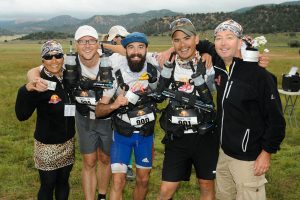Sailor goes ashore for epic and grueling “jog”
By Lookout on Oct 27, 2014 with Comments 0

Team Scrambled Eggs and Ham – LCdr Leung, Matt Campolongo and Colin Geddes – at the race finish with race directors Tex Geddes and Michael Templement.
Considered one of the most difficult ultramarathon on the planet, the Grand to Grand Ultramarathon (G2G) is gruelling says LCdr Francis Leung. It takes determined participants 273 kilometres, from the North Rim of the Grand Canyon in Arizona to the Grand Staircase in Utah.
The naval officer knows this firsthand, having recently completed the race over seven days across a distance similar to that of Victoria to Campbell River, through storms, sand dunes, caves, canyons, and rocky, mountainous terrain.
A veteran runner who put the sport aside for work and family, LCdr Leung considered training for the G2G as a way of regaining his edge,
“I was a competitive athlete most of my life, but after a series of injuries compounded by demanding work schedules, I got into a fairly sedentary lifestyle,” he says. “I needed something like this to get back into shape.”
LCdr Leung, and fellow runners Michael Templeman and Matthew Campolongo formed team Scrambled Legs and Ham. They set out Sept. 23 from the North Rim of the Grand Canyon, a legendary natural wonder.
With a storm front on their heels, LCdr Leung and his team made good time for the first day, but with just 50 km under their belts, they knew there was still over 220 km of more punishing terrain ahead of them.
“At one point on the first day, we could feel this cold front licking at our necks,” he says. “We later found out that the competitors behind us had to run through a flash flood with water up to their shins and chunky hailstones coming down on them. We were very lucky to miss that because it eventually contributed to conditions that took out over a quarter of the competitors from the race.”
Averaging over a marathon worth of kilometres each day, LCdr Leung and his team took on the terrain in a combination of trekking and running. Competing alongside ultramarathon veterans, LCdr Leung says his team operated under some hard and fast rules.
“We never ran up an incline. There was too much risk of fatigue and injury,” he says of their strategy. “At first, I was worried because the course had over 18,000 feet of ascent from start to finish, and we’d be walking too much, but it was more important to be efficient with our calorie burn since we were limited to the amount of food we carried [2,000 calorie per day was the race requirement minimum].”
As the name implies, ultramarathons are not for the faint of heart. The third stage of G2G was the most challenging for LCdr Leung and his team. Traversing 84.7 km, the three travelled on foot for almost 23 continuous hours.
“After a while you just suck up the pain in your feet and legs. In terms of sleeplessness, we’re not even thinking about it,” he says. “It’s a long time, but it’s akin to being on watch during certain submarine operations when you’re pulling virtual all-nighters. It takes the same kind of focus to dig deep, and just get through it.”
The terrain of the course varied as wildly as the competitors. From the plateaus of Arizona to the deserts of Utah, LCdr Leung said one of the biggest challenges came from the Coral Pink Sand Dunes State Park near Kanab, Utah.
“It was just beautiful. Since it was 1 a.m., moonless, and there was no civilization for miles, the sky lit up with stars as far as we could see,” he says. “The problem was for every two steps you took you’d slide back a step. We were using different muscles to stay steady, and that was definitely a gut check moment. We took about two hours to traverse five kiometres of very soft sand; it was tough but we made it.”
Finishing the race as a team was accomplishment enough, but LCdr Leung and Team Scrambled Legs and Ham took home the Top Team Award as well.
With ultramarathons happening all around the world, he plans to use this as a stepping stone to more adventures.
“My focus now is to bring my, speed back up,” he says. “I’ve got a lot of ideas for the future so we’ll see where they go.”
Shawn O’Hara, Staff Writer
Filed Under: Top Stories
About the Author:





